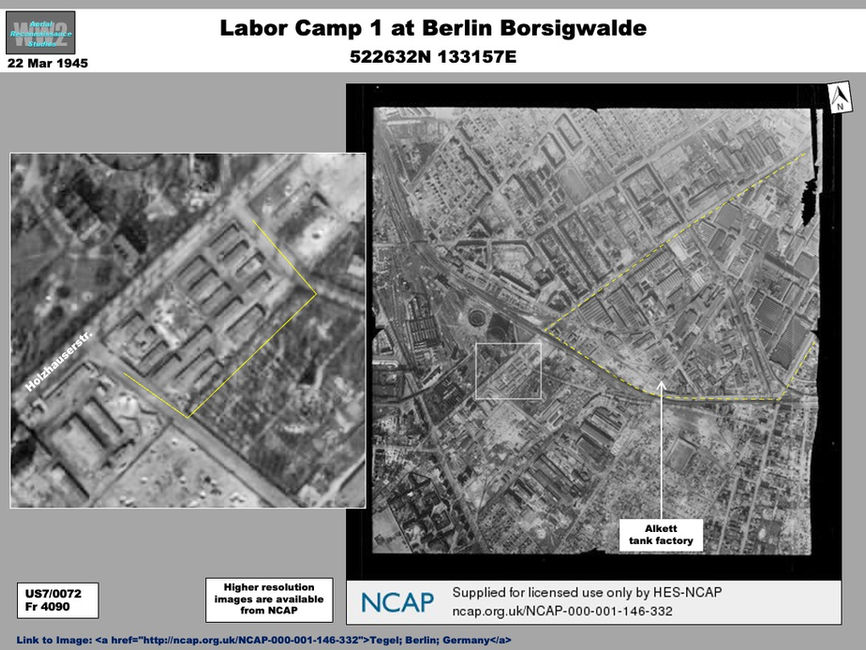WW2 AERIAL RECON STUDIES
Berlin Area Forced Labor Camps
Holocaust & POWs
The Third Reich’s economy relied heavily on forced labor (Zwangarbeit). Millions of people from conquered territories supported the war effort in Germany’s cities and countryside; most were from Eastern Europe, but the number also included prisoners from POW and concentrations camps. Most of laborers lived in temporary camps adjacent to industries or other workplaces. Living conditions in the camps varied with employers: volunteer workers from western countries enjoyed freedom of movement while those from the East endured harsh treatment.
The labor camps were ubiquitous in cities across Nazi Germany, but today the scope of the forced labor system is difficult to visualize. A search of imagery covering Berlin between 1943 and 1945 revealed more than 50 of the camps in the city (Map). There were surely many more, but the similarity of the camps to small military installations --often for anti-aircraft units-- made identification difficult. The camps were generally characterized by groups of hastily-erected wooden barracks with few amenities. They varied widely in size, ranging from five to more than 50 buildings. Except for camps housing prisoners, physical security was not high and some were not even fence-enclosed.
Two Alkett (Altmärkische Kettenwerke GmbH) armored vehicle factories in the Borgsigwalde quarter of northwest Berlin employed many forced laborers. In March 1945 at least seven labor camps, all of which are more or less typical, were identified around the factory. One, on Holzhauserstrasse, reportedly housed workers from Western Europe (Graphic). Selected examples of similar camps included six at Lichterberg, four at the Babelsberg film studio and a large camp (Weserflug) at Templehof Airport (Graphics).
A very large camp at Niederschönweide in southeast Berlin supported a railroad maintenance facility (Graphic). With four barracks sections (another was under construction), this installation was noteworthy for its size, orderly appearance and lack of security. At least three other more typical camps were located in the vicinity. A newer well-organized camp was identified in the Wedding quarter (Graphic).
By 1943 purpose-built installations for concentration camp prisoners and likely other laborers as well, were being set up in less-populated areas. Two Sachsenhausen subcamps at Falkensee in the western suburbs of Berlin provided labor for the construction and operation of a third Alkett factory Graphic). The original camp at the site had only six barracks and had guard towers, but on 6 September 1943, it was being expanded. A second, much larger camp with similar buildings was under construction immediately to the north (Graphic). Although fence-secured, this one lacked typical concentration camp security; a separately secured area and a single guard tower on the west side of the camp suggested that prisoners were confined to only part of the camp. A water line was being constructed to the new area. A much earlier camp, possibly a subcamp of POW camp of STALAG III-D was 500 m to the northwest (Graphic). In the mid-1930s prisoners from the camp extracted sand from a pit that became a small lake, the Neuer See. The camp was enclosed by security fences with six guard towers. A light rail led from the camp in the direction of the lake.
Similar camps were identified in the Hasselhorst and Hakenfelde quarters where Sachsenhausen subcamps were reported to be located. The largest of these, at Hasselhorst, was similar to the new camp at Falkensee and had a small separately- secured prison section (Graphic). However, there were no guard towers and the camp was not enclosed by a fence. By location this camp appeared to support a relatively new fuel depot on the nearby Havel Canal. One camp at Hakenfelde appeared to be under construction but did not have any security (Graphics). Another older camp and a possible Hitler Youth barracks were located nearby. Another camp with a small prison section was identified with the AEG electrical equipment plant at Henningsdorf, 6 km north of Hasselhorst. AEG was reported to have another Sachsenhausen subcamp (Graphic).
Sachsenhausen also supported work the Siemens Co. in Siemensstadt, 2.5 km southeast of Hasselhorst. Two fairly large camps were identified closer to the Siemens facilities, but neither had obvious prison sections (Graphic). In September 1943, one of these appeared to be fairly new and included a small barracks section (later removed).
POWs were a ready source of labor during the war. One of the main providers in the Berlin area was STALAG III-D, which had a subcamp at Grossbeeren (Graphic). The camp, with a typical layout, supported activities in a nearby railyard. Finally, even though it was not in Berlin, ‘POW’ written on the roof of a small industry in Bavaria illustrates how widely they were used (Graphic).

